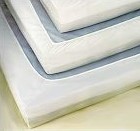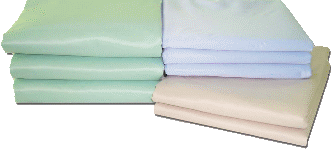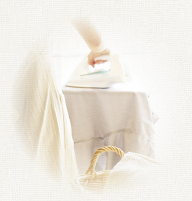Knit and Weave in Hospital Sheets
The difference between woven hospital sheets and knit hospital sheets is how the fabric is constructed. Woven sheets are constructed by weaving the yarn in and out in opposite directions. Knit sheets are constructed of a single strand of yarn that is knitted into rows of loops.
Typically knit hospital sheets have much more elasticity and will stretch while woven hospital sheets will not. Knit hospital sheets are also softer, thicker, and much warmer than woven sheets, which may be desired during colder months or in colder climates. However, knit sheets are also prone to pinholes, snags or runners that once started, can continually worsen with use and laundering and extend throughout the sheet. Woven sheets are much less likely to have this issue. Determining which sheet will work best for your situation can be left up to a matter of preference.
Woven Fabrics
Contrary to popular belief, the fabric content of woven sheets does not have as much to do with “softness” and “durability” of the sheet as the thread count. The higher the thread count, the more soft and durable the sheets will be. Thread count is the number of threads per square inch of fabric.
Muslin
Most hospital sheets are made from a lower-end T130 (or 130-thread count) muslin, which is quite standard within the healthcare industry. Muslin sheets are constructed of loosely woven cotton or poly blended cotton fabric and are typically listed at the bottom of the quality spectrum for softness and durability. These sheets are usually quite thin and if held up to a light, the light will be able to shine through fairly easily. A typical Muslin sheet will withstand approximately 75-100 institutional launderings. These hospital sheets are generally less expensive and work well for many institutions; however, they are not as soft and will not last as long as the alternative higher quality percale hospital sheets.
Percale
Percale hospital sheets are constructed of a T180 (or 180-thread count) and are similar to the quality of standard sheets you will find at your local home store for regular sized home beds. They are typically 100% cotton or made of a blended poly/cotton. A typical poly/cotton blended percale hospital sheet will withstand approximately 160-180 institutional launderings. Percale hospital sheets will almost always be softer and much more durable then their lower quality muslin counterparts.
Be sure to check which thread count you are purchasing before buying your woven hospital sheets!
Knitted Sheets
There are 3 common types of knit hospital sheets within the healthcare market. Jersey knit and Interlock knit are the more common types found; however, pique knit is gaining ground due to its ability to reduce runners from snags while in use or laundering.
Knitted hospital sheets are popular for many reasons. They will stretch 20-35%, which allows Knitted Fitted sheets to remain in place when hospital beds are raised and lowered so the corners do not slip off. They are more breathable and softer out of the package and do not require several launderings to “break them in” as can sometimes be the case with muslin or percale sheets. Knitted sheets are also well known for their ability to deter wrinkling, although this only applies when the sheet is stretched fully! Knit fitted sheets may be a good option if skin shear is an issue.
Knitted sheet quality is not rated by thread count, instead they are rated by the weight of their fabric. This is because knitted sheets are “knitted” and not woven. The higher the weight of the knit sheet (typically measured in ounces), the more thick, soft, and durable the sheets will be. They can be constructed of a number of different natural or synthetic materials, including cotton, polyester, rayon, etc. Knitted hospital sheets are typically made from cotton or cotton/poly material and most commonly sold as a bottom fitted sheets, which takes full advantage of the stretching ability of the fabric.
Jersey Knitted
Jersey knit is similar to the fabric found in most standard T-shirts. Jersey knit hospital sheets are usually constructed of a light to medium weight single knit that can be expected to stretch about 20-25%. The knitting process creates very fine vertical lines (marking the top of the sheet) on one side and a horizontal grain on the other (facing toward the mattress). The sheet will feel slightly softer and smoother on the top side, but in general will be soft and smooth to the touch. The only disadvantages to jersey knit may be the durability. Over time, with many launderings, jersey knit sheets are more prone to snags, runners, or thinning of the fabric and the fabric can become over-stretched as its elasticity diminishes.
Interlock Knitted
Interlock knit is constructed of a light to medium weight knit fabric that is a more resilient knit by forming a knot at the juncture of the threads to help prevent runs and resist pin-holes. Interlock knit sheets can also be constructed of a variety of fabrics and generally have a more natural and higher stretching ability from 25-35%. The Interlock Knit hospital sheets are also different from the jersey knit as they will be typically be thicker and both sides of the sheet will look and feel the same.
Pique Knitted
Pique is a method of knitting that creates a fine, textured mesh surface. This softly textured knit provides maximum protection from snags and runs, while remaining soft on the skin. The appearance of a pique knit fitted sheet is similar to that of a waffle weave. This is becoming more popular in the healthcare industry due to its greater durability while still remaining soft on the user’s skin.

Cheerful Pastel colors brighten a bedroom and offer a creative alternative to the standard white sheets usually available for hospital beds.

The soft and breathable Jersey Knit fitted sheet provides excellent skin comfort. The extra stretchy material helps prevent slipping when the bed is raised and lowered.

